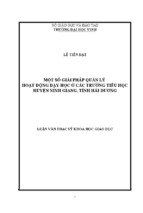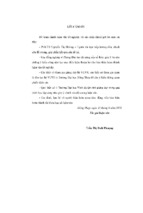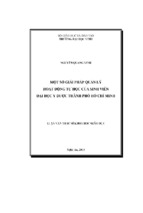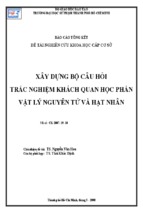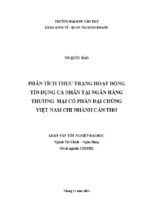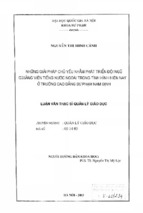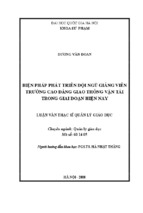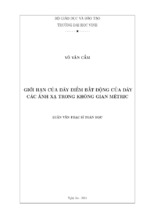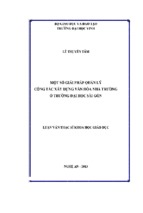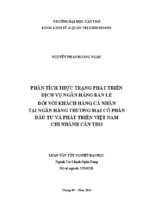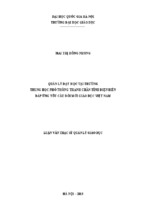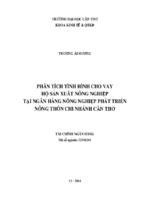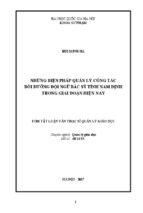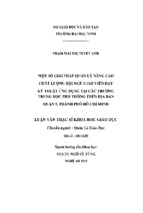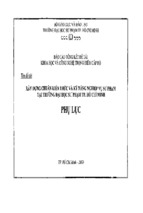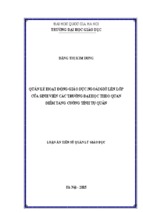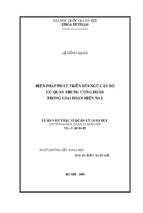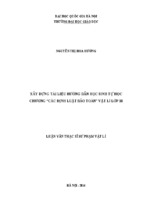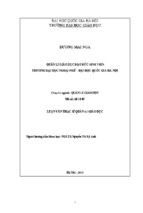The influence of mother tongue on second language learning has been a significant issue of research into second language acquisition, for mother tongue is an important part of learners’ linguistic background. The present research aims at (1) identifying the errors caused by L1 interference in written compositions, and (2) investigating learners’ perception of the reasons for such problems. The study employs error analysis to categorize errors in 106 written essays and organize interviews with students to explore their perceptions. The collected data from written essays and interviews are analyzed by quantitative and qualitative analysis. The results suggest that verb errors including verb voice and verb number are among the most prominent errors, while calque and collocation errors cause significant problems in lexis aspect. In terms of reasons behind L1 interference errors, two main causes are identified: the difference between Vietnamese and English, and learners’ L1 habit. The study indicates important pedagogical implications for English learning and teaching, which are expected to benefit stakeholders in ESL / EFL contexts.
VIETNAM NATIONAL UNIVERSITY, HANOI
UNIVERSITY OF LANGUAGES AND INTERNATIONAL STUDIES
FACULTY OF ENGLISH LANGUAGE TEACHER EDUCATION
GRADUATION PAPER
THE INTERFERENCE OF FIRST LANGUAGE
IN ENGLISH WRITING COMPOSITIONS: A
STUDY OF ENGLISH MAJORS AT A
LANGUAGE UNIVERSITY
Supervisor: Trần Thị Thanh Phúc, PhD.
Student: Đinh Bảo Ngọc
Course: QH2014.F1.E1
HÀ NỘI – 2018
ĐẠI HỌC QUỐC GIA HÀ NỘI
TRƯỜNG ĐẠI HỌC NGOẠI NGỮ
KHOA SƯ PHẠM TIẾNG ANH
KHÓA LUẬN TỐT NGHIỆP
ẢNH HƯỞNG CỦA NGÔN NGỮ THỨ NHẤT TIẾNG VIỆT ĐỐI VỚI VIỆC VIẾT TIẾNG ANH:
MỘT NGHIÊN CỨU VỀ SINH VIÊN CHUYÊN
NGÀNH TIẾNG ANH TẠI MỘT TRƯỜNG
ĐÀO TẠO NGOẠI NGỮ
Giáo viên hướng dẫn:
Trần Thị Thanh Phúc, PhD.
Sinh viên: Đinh Bảo Ngọc
Khóa: QH2014.F1.E1
HÀ NỘI – 2018
ACCEPTANCE PAGE
I hereby state that I: Dinh Bao Ngoc, class QH2014.F1.E1, being a candidate for
the degree of Bachelor of Arts (English Language Teacher Education) accept the
requirements of the College relating to the retention and use of Bachelor‟s
Graduation Paper deposited in the library.
In terms of these conditions, I agree that the origin of my paper deposited in the
library should be accessible for the purposes of study and research, in accordance
with the normal conditions established by the librarian for the care, loan or
reproduction of the paper.
Signature
Date
ACKNOWLEDGEMENTS
The six-month process of conducting this graduation thesis has been such a
valuable experience to me as a student researcher. Without the support of my
supervisor, my teachers and beloved people, the completion of this paper could not
have been possible.
Firstly, I would like to express my gratitude towards Dr. Tran Thi Thanh Phuc, my
supervisor, whose support and guidance has enriched my reservoir of knowledge,
strengthened my research skills and encouraged me to finish this research.
Secondly, I am thankful of all the participants of this study. Their substantial
assistance in the data collection process has facilitated the validity of the data and
the study in general.
Lastly, I owe great appreciation for my beloved family and friends for their
constant support, especially my classmates at QH2013.E1. These people have
provided me with important academic consultant, research resources and
emotional encouragement, which accompany me till the end of this journey.
Thanks to their invaluable help, I have matured as a researcher and have had the
determination to complete this research.
i
ABSTRACT
The influence of mother tongue on second language learning has been a
significant issue of research into second language acquisition, for mother tongue is
an important part of learners‟ linguistic background. The present research aims at
(1) identifying the errors caused by L1 interference in written compositions, and (2)
investigating learners‟ perception of the reasons for such problems. The study
employs error analysis to categorize errors in 106 written essays and organize
interviews with students to explore their perceptions. The collected data from
written essays and interviews are analyzed by quantitative and qualitative analysis.
The results suggest that verb errors including verb voice and verb number are
among the most prominent errors, while calque and collocation errors cause
significant problems in lexis aspect. In terms of reasons behind L1 interference
errors, two main causes are identified: the difference between Vietnamese and
English, and learners‟ L1 habit. The study indicates important pedagogical
implications for English learning and teaching, which are expected to benefit
stakeholders in ESL / EFL contexts.
ii
TABLE OF CONTENTS
Acknowledgements
Abstract
Table of Contents
List of abbreviations
List of figures & tables
i
ii
iii
v
vi
CHAPTER 1: INTRODUCTION
1
1.1. Background of the study
1.2. Statement of research problem and questions
1.3. Scope of the study
1.4. Significance of the study
1.5. Organization of the study
1
2
3
3
4
CHAPTER 2: LITERATURE REVIEW
5
2.1. L1 transfer and L1 influence
2.2. Different approaches to second language acquisition
2.2.1. Contrastive Analysis
2.2.2. Error Analysis
2.2.3. Error analysis process
2.2.4. Error classification
5
6
6
8
9
11
2.3. Overview of previous studies
2.3.1. Studies of L1 interference
2.3.2. Studies of Vietnamese influence on ESL learners
16
16
19
CHAPTER 3: METHODOLOGY
22
3.1. Research design
3.2. Participants
3.3. Data collection
3.3.1. Data collection instrument
3.3.2. Data collection procedure
22
22
23
23
24
3.4. Data analysis
3.4.1. Error Analysis
3.4.2. Interview data
25
25
27
iii
CHAPTER 4: FINDINGS AND DISCUSSION
29
4.1. Overview of found errors
4.2. Frequencies of error types
4.2.1. Grammar errors
4.2.2. Lexis errors
4.3. Discussion of L1 interference errors
4.4. Discussion of reasons for L1 interference errors
29
32
32
39
46
48
CHAPTER 5: CONCLUSION
52
5.1. Summanry of major findings of the research
52
5.2. Pedagogical implications
53
5.3. Limitations of the research
54
5.4. Suggestions for further study
54
REFERENCES
56
APPENDICES
61
Appendix 1
61
Appendix 2
63
Appendix 3
64
Appendix 4
66
iv
LIST OF ABBREVIATIONS
%: percent
CA: Contrastive Analysis
EA: Error Analysis
L1: First Language
L2: Second Language
EFL: English a Foreign language
ESL: English as a Second Language
TL: Target Language
v
LIST OF TABLES
Table
Name of table
Page
Table 1
Grammatical errors (Dagneaux, et al., 1996, cited in Lopez, 2009)
11
Table 2
Levels of errors (James, 1998)
12
Table 3
Types of lexical errors (James, 1998)
13
Table 4
Overview of related studies
16
Table 5
Error categorization chart
26
Table 6
Frequency of L1 errors
28
Table 7
Rank-order frequency of found grammar errors
31
Table 8
Rank-order frequency of found lexical errors
38
LIST OF FIGURES
Figure
Name of Figure
Figure 1 Error frequencies per category
vi
Page
30
CHAPTER 1: INTRODUCTION
This chapter presents the rationale of the study, states the research problems
and specifies the scope and significance of the study.
1.1.
Background of the study
In the new era of globalization, the study of English as a second language
has evidently claimed its international dominance. For learners from different
linguistic backgrounds, the process of second language acquisition encompasses
the trace of their mother tongue. In a broad sense, the mother tongue – the old
knowledge – can influence the acquisition of second language – the new
knowledge. This phenomenon is defined as “L1 transfer”, which can exert both
positive and negative effects on second language acquisition (Ellis, 1997, p.51). In
other words, when a person learns a foreign language, existing knowledge of the
mother tongue can create challenges for him or her in the learning process. Such
challenges are reflected in learners‟ errors, or interference errors, which are
specified as those that “can be traced back in their mother tongue” (Lott, 1983, p.
256). Since errors found in language learning can take roots from learners‟ mother
tongue, the study of L1 transfer is essential in an effort to improve the quality of
L2 acquisition (Ellis, 1997).
In the context of language learning in Vietnam, the challenges posed by L1
transfer can be considerable obstacles for Vietnamese ESL learners, considering
the great disparity between Vietnamese and English. Tran (2007) reports that
English is an inflectional language with German-Indo European origin, while
Vietnamese is a typical isolating language from the Austro-Asiatic language
family. The fact that Vietnamese is an isolating language, which means that words
do not change in form, certainly causes trouble to learners during their second
language acquisition process. (Mai, Vu & Hoang, 2003). Therefore, Vietnamese
ESL learners consequently encounter numerous challenges: the habits of using L1
1
can affect their acquisition of L2 in different language components. This reliance
may result in problematic language utterances or expressions, reducing the quality
of the language products. As errors in the language production (including spoken
and written forms) are inevitable, language intelligibility can be hampered with
such shortcomings (K. Nguyen, 2015).
As a student majoring in English at one of the most prestigious Vietnamese
universities, the researcher used to experience and have witnessed numerous cases
in which Vietnamese has a negative influence on students‟ English, particularly in
written form. From the researcher‟s experience, even English majored students
find this influence quite challenging. Therefore, the researcher has decided to
conduct an investigation into this issue. By examining sophomore students‟
writing pieces with proper error analysis process, meaningful implications could
be drawn to support the process of learning and teaching English.
Another motive to conduct this study is to contribute to the validity of
existing literature and enrich the scientific data in language transfer between
English and Vietnamese. Recently, various studies have been conducted on the
influence of other first languages such as Chinese (Timina, 2013; Wang, 2015),
Spanish (González, 2016) or Arabic (Hussein & Mohammad, 2011). However,
since each language has its individual distinction, these empirical findings can
barely provide generalizations about Vietnamese influence. Despite a wide range
of studies into L1 transfer, the number of studies into Vietnamese‟s influence on
ESL learners is quite limited. Two worth mentioning studies are that of K. Nguyen
(2015) which examines Vietnamese‟s influence on English acquisition and use of
people in Hanoi and that of Ha (2011) which studies L1 influenced written errors
made by high school students. Furthermore, undergraduate English majors are
uncommonly chosen as subjects of existing studies, most of which focus on nonmajored or high school students. This research, which focuses on English majored
2
students‟ errors in English writing with relation to their L1 impact, hopes to bridge
the gap in the existing literature of the field.
1.2.
Statement of research problem and questions
The study‟s primary purpose is to investigate the influence of mother
tongue on written compositions by examining L1 interference errors found in the
essays of English-majored students. The study also attempts to explore the
perception of the students on the reasons behind such errors. In general, the study
aims to answer the following questions:
i. What are the L1 interference errors made by students in their English
writing compositions?
ii. What are possible reasons for L1 interference errors as perceived by
students?
1.3.
Scope of the research
The research is conducted on a small population of English majored
students of one university in Hanoi. It investigates the negative influence of
Vietnamese as a mother tongue on English acquisition, specifically the errors in
lexis and grammar made as a result of L1 influence. Besides, within the scope of
this BA thesis, the research focuses on studying the written products of the
students and excludes other skill areas.
1.4.
Significance of the research
In achieving all the research goals, the researcher hopes to provide
beneficial resources for ESL scholars, teachers and students, as well as those who
share the interest in the topic. Since the research reports the errors committed as a
result of mother tongue influence, it would provide empirical evidence and
updated data to resolve the inadequacy of study on L1 interference in written
English. It would hopefully bridge the gap in existing literature about Vietnamese,
3
in particular, as a hindrance on SLA. Furthermore, the research would inform
readers, possibly ESL teachers and students, of the reasons behind errors caused
by L1 negative influence on writing skill. It would enable teachers and students to
adjust teaching and learning strategies to avoid L1 negative influence on written
compositions.
1.5.
Organization
The study report consists of 05 chapters as follows.
-
Chapter 1 – Introduction: The introduction presents an overview of the
research including the background of the study, the research problem, its
significance and scope.
-
Chapter 2 - Literature Review: The literature review includes a summary of
major concepts and frameworks for this research, namely L1 transfer, error and
error analysis, and a synthesis of related studies in L1 influence is also
included.
-
Chapter 3 - Methodology: This section presents the research design of the
study including the selection of participants, data collection, and data analysis
procedure.
-
Chapter 4 - Findings and Discussion: This section reports the result and
provides analysis and interpretation of the collected data.
-
Chapter 5 - Conclusion: This section sums up the findings and presents
pedagogical implications from the research, while stating the limitations of the
research and suggesting improvements for future studies.
4
CHAPTER 2: LITERATURE REVIEW
This chapter presents a review of the background literature of the study,
including the conceptual framework and existing studies related to the research.
The section starts with an overview of the definition of language transfer and
mother tongue influence, then moves on to review the error analysis approach in
second language study. The chapter also includes a review of related studies by
international and Vietnamese scholars, in which the gap in existing literature is
portrayed.
2.1. Language transfer and L1 influence
First language, or mother tongue, referred to the language that humans
acquired when they were at young age and that became a part of their development
(Saville-Troike, 2006). Saville-Troike (2006) also defined second language (L2)
as the additional language that people aimed to learn later in life, which is also
called target language (TL). Second language was of great importance in learners‟
education, employment and other fundamental fields.
Since people acquired different languages throughout their lives, there were
inevitable interactions among them. One of these interactions was language
transfer which was defined by Odlin (1989) to be the influence caused by
similarities and differences between the target language and prior acquired
knowledge (p. 27). This prior knowledge was not necessarily native language
knowledge but any other ones.
According to Ellis (1994), there existed several perspectives on language
transfer including behaviorist, mentalist and cognitive view (cited in Lu, 2010). A
simpler model of language transfer classification was made in consideration of
language transfer sources, results and levels by Huafei (2010, cited in Wang,
2015). Language transfer could be divided into interlingual and intralingual
5
transfer, positive, negative and neutral transfer, or into different linguistic levels
including phonetic, lexical, syntactic, semantic, pragmatic transfer.
In a multilingual context, language transfer could be observed in the
relationship among several languages. In second language acquisition area, Ellis
(1997) specifically discussed the influence of L1 on L2 and called it “L1 transfer”
which involved both positive and negative effects of L1 on L2 learning (p. 51). He
stated that L1 transfer could be one of the sources of errors in second language
acquisition. Saville-Troike (2006) explained this negative influence to be the
situation in which L1 knowledge was inappropriately applied to produce L2
utterances and therefore caused what was considered “error” (p. 19).
Transfer was also regarded as communication strategy or learning strategy.
Ellis (1997) explained that when learners with insufficient language knowledge
encountered communication, they developed communication strategies. For
example, they might borrow a L1 word to supply for a TL word they did not know.
Mahmoud (2000) reported transfer as a communication strategy or learning
strategy, by which hypotheses about the target language could be formed and
tested. James (1998, p. 188) mentioned calque (literal translation from L1 into L2)
and language switch (from L2 to L1) as two L1 based communication strategies
which resulted in language errors.
Meanwhile, Mitchell and Myles (2004) explained L1 negative transfer by
discussing L1 as a set of habit. They claim that when learners acquire L1, they
developed a “well-established” set of habits in language (p. 31). When learning L2,
learners had to adopt a new set of habits, therefore, they were presented with either
benefits or difficulties due to either the similarities or differences between the two
languages. From this belief, contrastive analysis approach was introduced.
2.2. Different approaches to second language acquisition
2.2.1. Contrastive analysis
6
In the 1950s, Contrastive Analysis became a popular theoretical view on
the issue. Lado (1957), a pioneer researcher on contrastive analysis theory, stated
that contrastive analysis attempted to anticipate and made meaning of L2 learners‟
difficulties based on the comparison between their L1 and L2. The approach was
based on Structuralism theory: CA compared L1 and L2 at each linguistic level to
point out the types of interference of L1 in L2 (Lado, 1957, cited in Saville-Troike,
2006). Besides, CA was created with an influence of Behaviourism in which
language learning was equated with the establishment of habits. In other words,
the greater difference between L1 and L2 was, the more challenges L2 the learner
might encounter (Saville-Troike, 2006; Mitchell & Myles, 2004).
Originating from distinctive language families, Vietnamese and English
features differed substantially. Tran (2007) presented a documentation analysis
where he compared description of English grammatical features of major linguists
like N. Chomsky, M. A. K. Halliday with that of Vietnamese linguists, namely
Diep Quang Ban, Cao Xuan Hao, or Hoang Trong Phien and so forth. He analyzed
the major similarities and differences in verbs, nouns and sentences in syntactic,
semantic, pragmatic aspects. It appeared that the two languages differed in various
aspects of verbs: from the structural aspect such as verb tense, finite verb form, the
use of “to be”, to the pragmatic and semantic aspects. For nouns, features such as
countable and uncountable nouns, noun complements were put into consideration
(Tran, 2007). The study provided a comprehensive report of the disparity between
two languages based on their commonly documented language features. Other
cross-linguistic studies also indicated meaningful comparisons of Vietnamese and
English features. For instance, Tang (2007) published a research on crosslinguistic features of the two languages on phonology and lexical semantics.
Another research by T. Nguyen (2015) presented the difference between spoken
and written English in comparison with Vietnamese, offering some valuable
insights into Vietnamese adverbials, adjectivals and subordination.
7
However, there existed some problems with a contrastive analysis approach.
More recent studies indicated that contrastive analysis did not accurately predict
learner‟s issues. Odlin (1989) stated that the sole comparison of two languages
could not anticipate certain errors made by students in L2 products. To be specific,
he brought up the circumstance in which Spanish EFL learners produced the
utterance “that very simple” without the verb “to be”, though Spanish and English
shared similar grammatical structure (p. 18). Another problem with contrastive
analysis approach was the scale of the task of comparing and contrasting two
languages. Norrish (1983) claimed that conducting a contrastive analysis of two
languages was not an easy task; it was challenging to devise a consistent
framework for contrast: a mere analysis of one sentence in L1 and its equivalence
in L2 could result in diverse interpretations.
2.2.2. Error analysis
In 1967, Corder (1967) introduced Error Analysis (EA), a theory that
focused on examining the errors made by learners in their target language. EA was
based on the idea that learning a language was not the memorization of rules but
the ability to learn and use language resource to create new utterances (SavilleTroike, 2006). Grami (2012) stated that EA offered more explanations of learners‟
errors than CA did, for the latter only predicted the errors caused by mother
tongue interference and excluded other factors. While CA analyzed the language
to predict learner‟s problem, EA regarded the learner – or more specifically, the
learner‟s errors – as the subject of analysis. Error analysis, thus, provided more
insights into other sources of learners‟ errors compared to CA.
One important concept of error analysis was how an error was defined.
Ellis (1994) defined error as the language element that deviated from the L2 target
language. It is important though, to distinguish different terms relating to errors.
Norrish (1983) presented the difference among an error, a mistake and a lapse. An
error referred to something learners constantly did incorrectly because of lack in
8
knowledge. A mistake was a result of inconsistent use of a language item; learners
might use it correctly or incorrectly at times. A lapse resulted from other factors
unrelated to the learning process such as lack of concentration or fatigue. Ellis
(1997) also emphasized the need to clarify errors and mistakes, suggesting that the
consistency in learners‟ production of wrong language might assist the
identification of errors and mistakes.
The identification of errors claims its role in the process of teaching and
learning L2. Since errors are produced by learners in their learning process, they
reveal learners‟ ability and their progress. This point was supported by Gass and
Selinker (2001), who stated that errors can act as “red flags” which could reflect
learner‟s progress in their L2 learning (p. 78). Furthermore, Saville-Troike (2006)
regarded errors as “the window to language learner‟s mind” (p. 39), emphasizing
the important information that errors could reveal about language learners. Zaphar
(2016) stated that only by identifying errors could learners resolve errors, making
EA an essential task in L2 learning. All in all, investigating errors was of great
vitality in improving the quality of L2 acquisition. To achieve the purpose of this
study, it has been pinpointed that Error Analysis is an appropriate approach to the
research methodology.
2.2.3. Error analysis process
Ellis (1997) suggests that there are a number of steps to apply in the
procedure of error analysis.
-
Collecting samples of learner language
-
Identifying the errors
-
Describing the errors
-
Explaining the errors
-
Evaluating/correcting the errors
9
Collecting samples of learner language: The first step of the process is to
select the sample for analysis. The type of EA can be classified according to the
size of the sample which can be massive, specific or incidental. Massive sample
refers to several language samples from various students, while specific sample is
a collection of one sample from a limited number of students. Incidental sample
consists of one language sample from one student. Samples can be collected either
at one single time or over a period of time. Since learners‟ errors can be affected
by various factors, it is essential to consider language factor (medium, genre,
content) and learner factor (level, mother tongue, language learning experience) in
the process of collecting samples.
Identifying the errors: Next, errors must be identified. With the collected
samples, the initial task is to determine the language elements that deviate from
the L2 or the target language.
Describing the errors: At this step, the errors can be categorized by
linguistic levels (morphology, syntax, and vocabulary), grammatical categories, or
the way they deviate from the reconstructed utterances in the target language (Ellis,
1994; Ellis, 1997; Saville-Troike, 2006).
Explaining the errors: When the errors are categorized, the important task
is to explain their sources of errors. This process gives important insights into the
origin of errors and create meaningful pedagogical implications. According to
Gass and Selinker (2001), there are two types of errors in error analysis:
interlingual and intralingual errors. While the former refers to L1-related errors,
the latter refers to those related to the target language. To be specific, interlingual
errors, or transfer errors are regarded as the errors caused by mother tongue
interference. For example, the students can write a sentence in English with a
Vietnamese structure.
Evaluating the errors: After finding the origins of errors, the last step is to
analyze the effects that errors exert on people addressed. The process involves
identifying who to be addressed, what errors to be evaluated and the people to
10
- Xem thêm -

